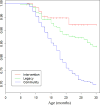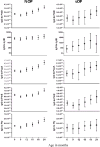Ten-Year Study of the Stringently Defined Otitis-prone Child in Rochester, NY
- PMID: 27273691
- PMCID: PMC4987181
- DOI: 10.1097/INF.0000000000001217
Ten-Year Study of the Stringently Defined Otitis-prone Child in Rochester, NY
Abstract
This review summarizes a prospective, longitudinal 10-year study in Rochester, NY, with virtually every clinically diagnosed acute otitis media (AOM) confirmed by bacterial culture of middle ear fluid. Children experiencing 3 episodes within 6 months or 4 episodes in 12 months were considered stringently defined otitis prone (sOP). We found stringent diagnosis compared with clinical diagnosis reduced the frequency of children meeting the OP definition from 27% to 6% resulting in 14.8% and 2.4% receiving tympanostomy tubes, respectively. Significantly more often respiratory syncytial virus infection led to AOM in sOP than non-otitis-prone children that correlated with diminished total respiratory syncytial virus-specific serum IgG. sOP children produced low levels of antibody to Streptococcus pneumoniae and Haemophilus influenzae candidate vaccine protein antigens and to routine pediatric vaccines. sOP children generated significantly fewer memory B cells, functional and memory T cells to otopathogens following nasopharyngeal colonization and AOM than non-otitis-prone children and they had defects in antigen-presenting cells.
Figures





References
-
- Thompson D, Oster G, McGarry LJ, Klein JO. Management of otitis media among children in a large health insurance plan. Pediatr Infect Dis J. 1999;18(3):239–244. - PubMed
Publication types
MeSH terms
Substances
Grants and funding
LinkOut - more resources
Full Text Sources
Other Literature Sources
Medical
Miscellaneous

